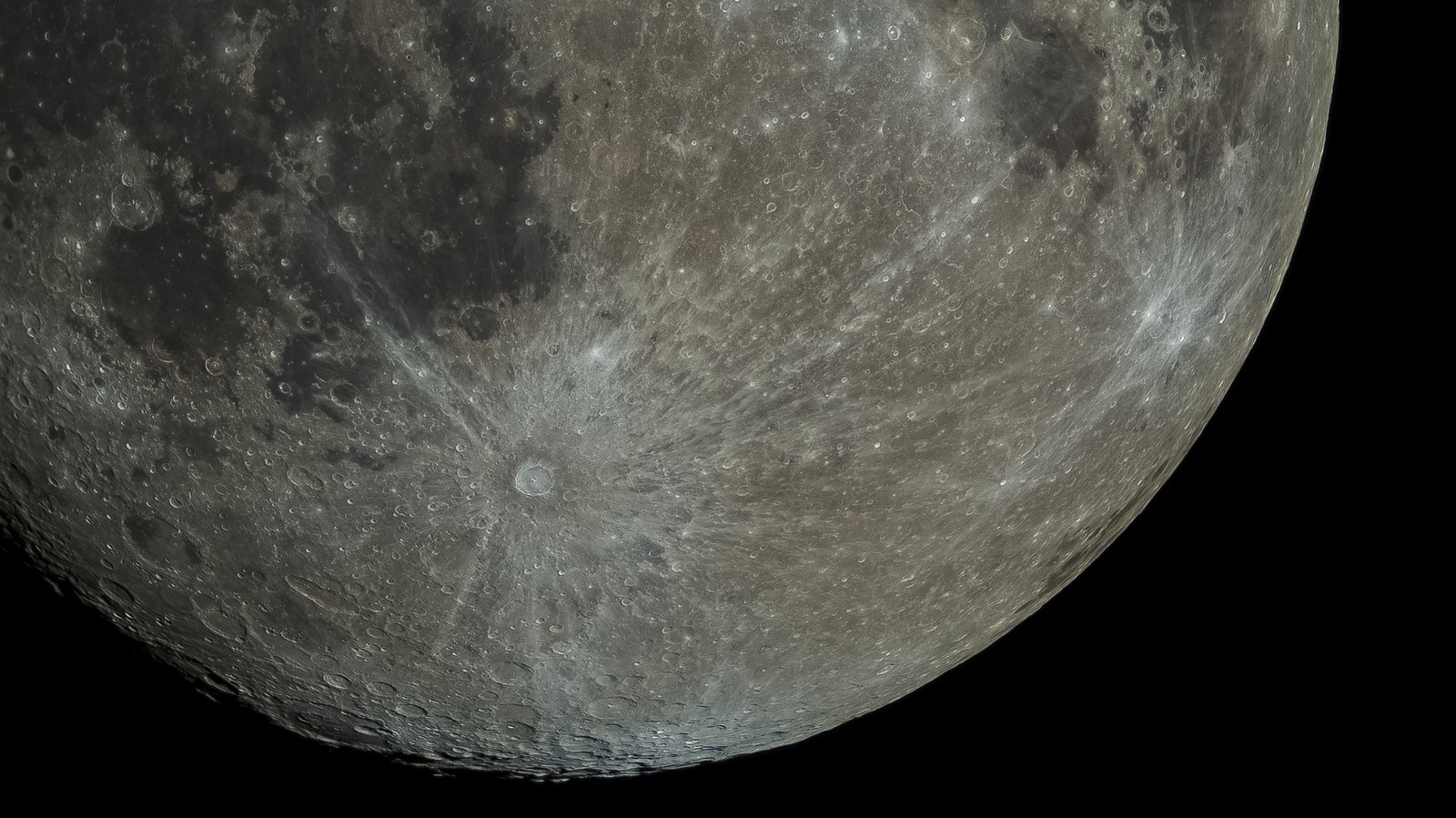Why The Lunar South Pole Is So Important To Scientists – Grunge

Why The Lunar South Pole Is So Important To Scientists – Grunge
The series of U.S. Apollo missions, including Neil Armstrong’s moonwalk back in 1969, all took place on the moon’s northern hemisphere. From 1969 to 1972, the U.S. landed at six different spots on the moon’s surface, all on the side facing Earth because it was easier to navigate and keep in communication with mission control. But as it turns out, it’s the other side of the moon that holds more interest to scientists.
On August 23, 2023, India became the first nation to reach the lunar south pole when the unmanned Chandrayaan-3 spacecraft landed there, per NBC News. This side of the moon, which we never see from our vantage point on Earth, may hold more lunar ice than the northern hemisphere. According to Reuters, this ready supply of water could be used in helping to establish a permanent base there or in missions to Mars.
A crucial resource
 Space Frontiers/Getty Images
Space Frontiers/Getty Images
Scientists have been aware of the possibility of ice on the moon for more than 20 years, ever since a NASA space probe first detected what turned out to be ice on its surface. In 2018, the space agency finally “directly observed definitive evidence of lunar water ice,” with much of it concentrated on the south pole in massive craters where it’s especially cold and dark, according to NASA.
Besides the obvious benefit of moon colonists having a ready supply of water to drink, space explorers could, by separating the water’s oxygen and hydrogen molecules, use the former to breathe and the latter as fuel. Finally, scientists are also interested in the ancient ice, possibly billions of years old, as a means to learn more about the origins of both the moon and Earth. It’s believed the ice may have ended up on the moon when water-laden asteroids crashed onto its surface.
Solar power and the distant past
 muratart/Shutterstock
muratart/Shutterstock
Beyond the lunar south pole’s water resources, its location allows for near-constant exposure to the sun, perfect for a solar-powered manned moon station. Unlike on Earth, at the moon’s poles, the sun doesn’t rise and set but instead circles around, thus providing a steady power source via areas that are almost always illuminated.
Scientists are also interested in the lunar south pole as a place to study low-frequency electromagnetic waves from distant parts of the universe that are impossible to study on Earth because of things like radio and television waves that drown them out. By studying these electromagnetic waves, they can better understand the beginnings of the universe. Still, lunar ice seems to be at the top of the list of reasons various nations are racing to the “dark side” of the moon. The U.S. has plans for a manned mission there in 2025, and Russia just had a failed attempt with an unmanned probe, per Reuters and NASA. Like here on Earth, it’s about the potential exploitation of resources.
Related News & Content
-

Limit taxonomy terms added to a custom post type
Limit taxonomy terms added to a custom post type,I've created a Custom Post Type and a Custom Taxonomy. In WP Admin, how can I limit amount of taxonomy terms that are added to the custom post type? I want to add no more than one tag into the post. Tags: custom post types custom taxonomy limit stackexchange.com WordPress Development Stack Exchange -

Query top level custom post in taxonomy
Query top level custom post in taxonomy,This is my first post, I'm a bit stuck. I have a custom post (dan) and taxonomy (dnas), with hierarchical categories. I want to make a query resulting in posts at toplevel (hoofdcategorie01, Tags: stackexchange.com taxonomy WordPress Development Stack Exchange wp query -

Gutenberg: Restrict Top Level Blocks, But Not Child Blocks
Gutenberg: Restrict Top Level Blocks, But Not Child Blocks,Background I've created a custom top level "page section" block, to work with my existing theme. I've like to restrict top level blocks to ONLY that one block. However, I don't want to di... Tags: block editor stackexchange.com WordPress Development Stack Exchange -

How do I load styles into the block editor admin screen?
How do I load styles into the block editor admin screen?,The core file 'load-styles.php' generates css styles. Some of the styles interfere with the block editor. I would like to pass in my own style rules that override the styles generated by 'load-styl... Tags: block editor stackexchange.com WordPress Development Stack Exchange -

Installing WordPress in a subdirectory
Installing WordPress in a subdirectory,I am trying to install wordpress into a subdirectory of a website. I simply want to build the client's new site in this subdirectory, so a separate and new WP install in this subdirectory, and the... Tags: installation stackexchange.com WordPress Development Stack Exchange -

Custom theme and plugin updating
Custom theme and plugin updating,History: I'm working on a project for a client that involves building 27 unique websites that are built on wordpress. I say unique, because (for reasons that are not worth going into here) they ar... Tags: automatic updates plugin development stackexchange.com theme development WordPress Development Stack Exchange -

Rewrite nested urls for custom post type
Rewrite nested urls for custom post type,I have a problem with nested permalink. I have a structure of urls like that: Catalog -> Category -> Product My urls are: www.domain.com/catalogs (for archive catalog) www.domain.com/catal... Tags: custom post types stackexchange.com url rewriting WordPress Development Stack Exchange -

Ajax not working to insert, query and result data
Ajax not working to insert, query and result data,On my site, through a form I send/register same information in database, do a SELECT/query and return it! Return the last table saved in database, just that user just entered on the form (along wit... Tags: Ajax database functions plugin development stackexchange.com WordPress Development Stack Exchange -

Israel at war, day 204: Hamas airs video of Israeli hostages, one with U.S. citizenship
Israel at war, day 204: Hamas airs video of Israeli hostages, one with U.S. citizenship,Hamas Studying Israel's Response to Position on Cease-fire Talks Gaza Aid Shipments Resume From Cyprus IDF: Two Palestinians Killed After Firing on IDF Outpost in the West Bank Pro-Palestinian Protest Leader Banned From Columbia Campus Here's What You Need to Know 204 Days Into the War Tags: 2023 Israel Gaza War haaretz.com Israel News -

Carol Kirkwood stuns in figure-hugging dress amid BBC Breakfast technical chaos
Carol Kirkwood stuns in figure-hugging dress amid BBC Breakfast technical chaos,CAROL Kirkwood stunned in a figure-hugging dress amid a technical blunder. BBC Breakfast was flung into chaos this morning after a string of sound issues. However Carol, 61, was all smiles as she p… Tags: BBC BBC Breakfast BBC ONE Carol Kirkwood mirror.co.uk The Scottish Sun TV News TV UK daytime TV -

Families ‘to sue prison’ where loud inmates ‘terrorise kids’ with screaming
Families 'to sue prison' where loud inmates 'terrorise kids' with screaming,Residents living next door to a new prison who say their kids have to sleep wearing headphones and some leave during weekends due to the racket are threatening to sue the prison service Tags: mirror.co.uk Neighbours from hell prisons Scottish government The Mirror -

Doctor Strange’s Secret Wars Role May Be More Important Than You Thought – Looper
Doctor Strange's Secret Wars Role May Be More Important Than You Thought - Looper,According to entertainment leaker Alex Perez, Doctor Strange will find himself confronting his inner struggles as he headlines "Avengers: Secret Wars." Tags: Fiction Looper looper.com Marvel Cinematic Universe Science Star Wars The Universal Monsters franchise -
What Kris Jenner Has Said About Those O.J. Simpson Affair Rumors – Nicki Swift
What Kris Jenner Has Said About Those O.J. Simpson Affair Rumors - Nicki Swift,Over the years, plenty of gossip has swirled about the Kardashians. Here's what Kris Jenner has said on those affair rumors about O.J. Simpson. -
Why We’re Worried About Khloe Kardashian – Nicki Swift
Why We're Worried About Khloe Kardashian - Nicki Swift,Although Khloé Kardashian has seemingly picked up the pieces of her life after turmoil, there's no denying that we are still worried about the reality star. -

ITV boss reveals Mr Bates vs The Post Office drama made a loss of around £1m
ITV boss reveals Mr Bates vs The Post Office drama made a loss of around £1m,ITV boss Kevin Lygo has revealed the hit drama Mr Bates vs The Post Office made a loss of around a million pounds. Tags: Entertainment Mr Bates vs the Post Office The London Economic thelondoneconomic.com -

Miriam Margolyes ‘worries about’ Harry Potter fans because ‘they should be over it by now’
Miriam Margolyes ‘worries about’ Harry Potter fans because ‘they should be over it by now’,The actor revealed that she often gets requests on Cameo from fans who are having Harry Potter-themed weddings. Tags: Entertainment The London Economic thelondoneconomic.com -
Electoral Court ‘deeply fractured’ in its interpretation of Zuma/MK case: IEC
Electoral Court ‘deeply fractured’ in its interpretation of Zuma/MK case: IEC,Electoral Commission asks apex court to resolve split in Electoral Court's thinking in new court papers Tags: Africa breaking news business times concourt Constitutional Court dumisani zondi electoral court Entertainment extra first General iec electoral commission jacob zuma lebogang modiba lifestyle MK mk party News nomthandazo ntlama makhanya Politics retselisitsoe phooko Sport Sunday times The Times thisjustice modiba times TimesLIVE timeslive.co.za tshisa live Weird WORLD -
Zuma seeks recusal of five 'tainted' ConCourt justices in IEC case
Zuma seeks recusal of five 'tainted' ConCourt justices in IEC case,Former president Jacob Zuma has counter-applied to the Constitutional Court for the recusal of five of its justices in his battle with the Electoral Commission (IEC) over whether he is eligible to stand for parliament. Tags: Africa Anc breaking news business times concourt constitution electoral commission electoral court Entertainment extra General honourable justices IEC jacob zuma leona theron lifestyle mbuyiseli madlanga mk party Mps News nonkosi mhlantla nqobile zungu Parliament Politics Sport stevan majiedt Sunday times supreme court of appeal The Times times TimesLIVE timeslive.co.za tshisa live umkhonto wesizwe political party Weird WORLD zukisa tshiqi
Warning: file_get_contents(https://www.scienceradars.com/wp-output-content.php?pg=1&cat=&kw=&lvl=): Failed to open stream: HTTP request failed! HTTP/1.1 526 in /home/wwwroot/xuenou.com/wp-content/themes/chromenews/template-parts/content.php on line 169
Warning: file_get_contents(https://www.bayuexiang.com/wp-output-content.php?pg=1&cat=&kw=&lvl=): Failed to open stream: HTTP request failed! HTTP/1.1 526 in /home/wwwroot/xuenou.com/wp-content/themes/chromenews/template-parts/content.php on line 173
TrendRadars
The Most Interesting Articles, Mysteries and Discoveries


































